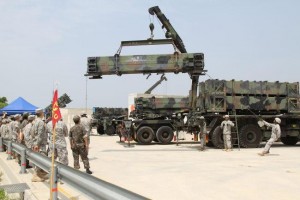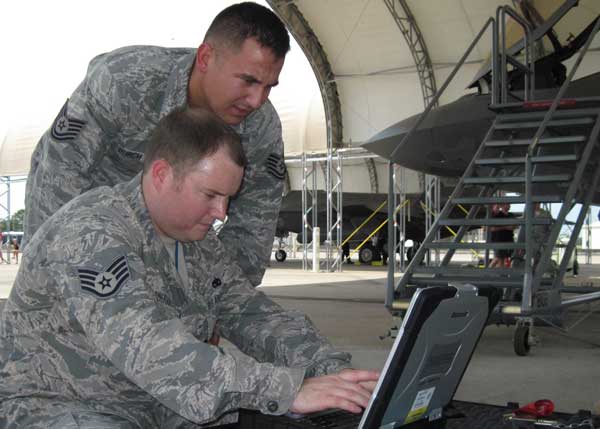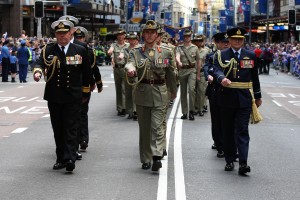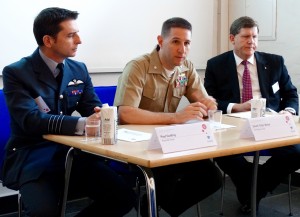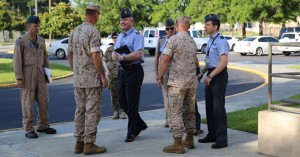2015-10-25 By Robbin Laird and Ed Timperlake
There is understandable concern about Russia stepping up its involvement in Syria.
The Russians have taken ownership of Assad and his regime.
Now it has evolved way beyond merely word posturing, there is an immediate need for the U.S. and Allies to engage with both strategic and tactical military and diplomatic actions in the region.
The focus for action is direct and not complicated; defeat of ISIS, while supporting the Kurds in reshaping our position in Iraq, and putting the Iran nuclear agreement in the dust bin of history as it is recognized that one of the key architects of the agreement has clearly indicated they have no intention of playing an even handed role.
There is a clear and present danger of miscalculation, which needs to guide U.S. and our Allies to work directly with the Russians in the deconfliction of air space. We need as well to come to terms with the end of the latest age of unmanned aerial vehicles.
Not only are the Russians putting our UAVs in risk, but the information war is being lost to Russia as of today new documents have been leaked which put the United States into a moral abyss.
According to Russia Today:
A cache of classified documents has revealed the inner workings of US drone operations in Somalia, Yemen and Afghanistan, including the mechanism of targeting suspects slated for assassination.
The documents were provided to The Intercept by a source within the US intelligence community who wished to remain anonymous because of the government’s aggressive prosecution of whistleblowers. The documents, slides, visuals and analysis have been posted by The Intercept on Thursday as “The Drone Papers.”
Russia has had a significant stake in Syria for a long time, and Syria is part of their Mediterranean resurgence under Putin.
For Secretary Kerry when looking at Russia’s actions in the Ukraine, Putin was declared to be so 19th Century.
In reality, Putin is using military power in a 21st century way – to support a strategy of influence and strategic positioning.
http://sldinfo.wpstage.net/syria-and-the-russian-recovery-putin-on-center-stage/
And in the face of Russian strategy in Syria, the lack of clarity in U.S. strategy and the use of the U.S. military to support strategic incoherence is leaving it exposed.
Rather than pursuing the advantages of the strategic shift to fifth generation warfare, an opportunity highlighted in a recent interview with ACC Commander “Hawk” Carlisle, Russian actions in Syria are pushing the U.S. back to the beginnings of airpower in World War I, where fighters operated to protect observation balloons.

Disregarding the warnings of the recently retired head of ACC., General Mike Hostage, not to fly UAVs in contested airspace, now the vulnerable assets are facing Russian aviation in a potential face off. Either these assets are removed for their own protection, or pilots will fly to protect them, and engage the Russians in a World War I style of warfare.
This should underscore the clear limits of relying on UAV technologies except in unique circumstances, namely air dominance and clear strategic purpose.
In 2001, President George W. Bush claimed he had looked into Putin’s eyes and “was able to get a sense of his soul.” Clearly, Putin has done this with Obama, and his Syrian actions are playing off of what Putin sees as the Obama strategy which includes a pro-Iranian stance, an alienation of Israel, a pro-Baghdad Iraq policy, and a very weak “air campaign” with more lawyers than airstrikes.
Putin is backing a sitting government, that of Assad. One should remember that the bias in the UN Charter is to support sitting governments and that Russian claims that Western strikes in Syria are illegal under the UN charter is not simply hyperbole. Russian actions in support of Assad also expose the incoherence of the “other side” supporting the mishmash of opponents of Assad, ranging from ISIS, to legitimate opponents of Assad.
With a clear military force on the ground, namely those of Assad, and in support of the legitimate government of Syria, Russian airpower can rely on Syrian forces to help indicate targets, and can prosecute the enemies of Assad as well as ISIS in Syria.
And with no lawyers in the OODA (Observe, Orient, Decide, Act) loop, Russian pilots are not constrained by the OOLDA (Observe, Orient, Legally Review, Decide, and Act) loop which has taken away the effectiveness of Western airpower.
To be clear, this is not about “ground forces” versus “airpower” for all operations are now air-enabled.
This is about a clear strategy within which military assets can be used. And Putin is clearing the decks to expand his influence in the region in the face of strategic incoherence and lack of strategic operational clarity for Western militaries.
Putin went to Paris recently and cut a deal with Ukraine to take Ukraine off the table for the moment. Putin is trying to put the lid on Syria, which would be supported by many Europeans, for this could provide relief from the crisis in Europe surrounding the upsurge of migration from the region.
Putin has met with the Israel leader and the Israeli military as well and they have discussed the way ahead in the region. Whereas President Obama is giving the cold shoulder to Netanyahu, Putin welcomed him to discuss the region and the way ahead on security arrangements.

The Russians have deployed missile defense systems around their main operating base, thereby deterring Western air forces. To be clear, there is little doubt that these defenses could be destroyed if needed, but what is the point?
The Iranians seem to be getting the point, that strategy-led military operations in support of a legitimate government in Syria – however brutal – makes the Russians a key player to be dealt with, especially one which can deal with Europe and Israel at the same time.
Calibrated military force supporting a strategy is what Putin has put in play certainly since the Crimean takeover.
In contrast, the Obama Administration has put in play an incoherent military operation against “ISIS” without clear allies on the ground, although as we have argued earlier, he had a clear opportunity with regard to the Kurds to reshape the partner mix.
http://breakingdefense.com/2014/12/a-calibrated-response-to-isil/
Putin’s clear actions against Obama’s behavior, only enhances the opportunities for the Russians to influence events and shape outcomes. The PR “glow” from the Iranian agreement is already in the rear view of history; Iran’s Supreme Leader Ayatollah Ali Khamenei has declared that the strategic opening claimed by the Obama Administration is already dead on arrival.
Mr. Khamenei scoffed at the notion of talks with Washington of any kind, saying nothing positive would emerge from them for Iran. “Negotiation with the U.S. is banned because of the countless harms it inflicts,” the supreme leader’s official website quoted him as saying. “Besides, [negotiation] has no advantage, either. We are against negotiations with the U.S. because talks with the U.S. mean infiltration. They want to open the way for imposition.”
http://www.wsj.com/articles/irans-supreme-leader-bars-further-talks-with-u-s-1444220022
In contrast, the Russians have met with Iranian leaders over the past few months as a prelude to their latest Syrian actions. Put in other terms, military power in support of a clear regional strategy serves Putin’s purposes. And playing early “Gen 1” World War I type airpower makes little sense in supporting an effective strategy.
Simply opposing Putin will get the U.S. nowhere without recognizing how the game has already changed and the approach to counter-insurgency which the U.S. has followed for a decade, along with attachment to UAV-enabled ground operations has been overtaken by events.

And there is a clear need to get on with the strategic task of de-conflicting the Western and Russian air forces operating in the murky border regions of Iraq and Syria, notably with the ISIS operating with fluidity within the “borderless” region from their point of view.
It should not be forgotten that European Air Forces have been engaging with the Russians over the Baltic and North Sea regions, and already have some sense of what the current Russian air operations are all about.
And Western Air Forces, such as the RAF have already made it clear that they will not tolerate any direct threat to their forces as well in Iraq.
Working the fluidity is not simply a tactical issue; it is a strategic one.
And Putin has clearly put his marker down to be a player and kingmaker in the region.
For Putin, Russian airpower is a key instrument in his strategy and one not constrained by the OOLDA loop.
For earlier pieces on this topic, see the following:
http://sldinfo.wpstage.net/syria-and-the-russian-recovery-putin-on-center-stage/
http://sldinfo.wpstage.net/making-sense-of-moscow’s-syrian-gambit/
http://sldinfo.wpstage.net/beyond-crimean-annexation-the-russians-look-to-the-wider-mediterranean/
http://sldinfo.wpstage.net/beyond-crimean-annexation-the-russians-look-to-the-wider-mediterranean/
According to a Pravda article which was published on October 7, 2015on Russia and US drones over Syria, the incidents were also tied to the information war points raised above:
US TV channel Fox News has recently reported that Russian aircraft intercepted elusive US MQ-1 Predator drones in the Syrian Sky three times.
After the first incident of interception, Pentagon officials said that that Russians were just lucky.
However, two other incidents occurred soon afterwards, although the Russian aircraft did not try to down the unmanned aerial vehicles, but simulated interception instead.
Fox News said that the incidents occurred above the ISIS-controlled territory of Syria, above the “capital” of The Islamic State – the city of Rakka, near the Turkish-Syrian border, not far from Kobani and Aleppo.
A specialized military publication confirmed in 2014 that Russian anti-aircraft troops forced a US military drone to land during the time of the Crimean crisis and referendum in March 2014.
“The Ukrainian side tried to organize aerial reconnaissance above the Crimea with the use of unmanned aerial vehicles. The latter were part of the 66th military reconnaissance brigade headquartered in Bavaria, Germany, and deployed in Kirovograd, Ukraine. Yet, neither the US nor Ukraine managed to keep the Crimea and Russia’s Black Sea Navy under control.
“As a result if the measures taken, two Israeli-made unmanned drones, MQ-5B Hunter, were intercepted. One of them was downed by militia forces on March 10, another one was forced to land with the help of a Russian ground-based radio technical reconnaissance system Avtobaza,” Russian military officials said.
Earlier, the bureau of journalistic investigation reported that in sixty percent of cases, US drones attack and bomb buildings. According to Washington’s Blog, up to 90 percent of victims of American drone attacks are civilians.
“I’m really good at killing people,” US President Barack Obama said once at a meeting with defense officials.
For Lt. General (Retired) Deptula’s assessment of the current airpower being conducted against ISIL, listen to the following interview on October 12, 2015 with WYNC:
And in Defense News, Deptula had this to say about the air campaign:
Even the 1999 Kosovo campaign and the 2001 strikes against the Taliban in Afghanistan dwarfed OIR’s strikes launched. These air campaigns averaged 138 and 86 strike sorties a day, respectively.
This limited application of air power to destroy ISIS raises questions about the administration’s objectives, according to retired Lt. Gen. Dave Deptula, former deputy chief of staff for intelligence, surveillance and reconnaissance.
“To what end it’s still unclear, particularly since the application of air power to date, while enormously precise and effective to the extent that it has been applied, the degree to which it has been applied is very, very, very limited relative to what the potential application of air power could be,” Deptula told Defense News. “So there’s a lot of confusion of just what are the US critical national security objectives that the application of force today has been aimed at.”
Deptula also pointed out that OIR is lead by an Army general: Lt. Gen. James Terry. This begs the question, he said, if the administration’s goal is to take out ISIS through the use of air power alone, why put an Army commander in charge of the air campaign?
The administration’s “anemic” action against ISIS has created a void in the region, one that Russia is all too happy to fill, Deptula said.
“They are taking advantage of a less-than-robust US military effort regarding the Islamic State to dramatically increase their presence in the Middle East,” he said, adding that Russia’s moves in recent days have shown “not only can the Russians walk and chew gum, they can also play chess.”
The initial version of this piece was published by Breaking Defense.
Obama Must Act On Syria Or Putin Runs The Show
By ROBBIN LAIRD and ED TIMPERLAKEon October 16, 2015 at 10:23 AM



